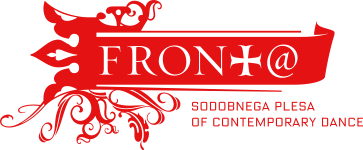
petek, 31. avgust ob 20.30
Friday, 31 August, 8.30 pm
Improvizacijski napad/Improvisation Attack
(ob živi glasbi harmonikarskega tria SLO A3/to live music by the accordion trio SLO A3)
Glasbeni nosilec Improvizacijskega napada na zadnji dan druge izdaje festivala Front@ bo harmonikarski trio SLO A3 (Borut Mori, Dejan Prasl, Matej Zavec). Skupina študentov Univerze za glasbo in upodabljajočo umetnost v avstrijskem Gradcu deluje od leta 2003, ko se udeleži avdicije pri avstrijski agenciji Live Music Now, ki z organiziranjem samostojnih koncertov pomaga mladim umetnikom na začetku njihove kariere – njihovo ime je svojevrstna enačba: A3 pomeni kratico za harmonikarski trio (A = Akkordeon), kot študentje v tujini pa so fantje morali imeti tudi potrjeni obrazec zdravstvenega zavarovanja za tujino, ki nosi oznako SLO_A3.
Po uspešni avdiciji trio nadaljuje koncertno pot po Avstriji, Sloveniji, Italiji, na Hrvaškem in Madžarskem. Sledilo je več nagrad na mednarodnih tekmovanjih: zmagi leta 2005 v Trstu in v Pulju; leta 2006 drugo mesto na tekmovanju v Castelfidardu in vnovična zmaga na tekmovanju v Trstu. Repertoar tria zajema glasbena dela iz obdobij baroka, klasicizma, romantike in avantgarde. Poleg tega SLO A3 igra tudi argentinski tango, francoski mussette in filmsko glasbo. Sodeluje s priznanimi skladatelji (U. Rojko, A. Trikoupis, S. Šuklar), ki med drugim pišejo tudi posebej zanje.
Več o triu izveste na spletni strani www.slo-a3.com.
Musical support of the Improvisation Attack on the last day of this year's Front@ will be produced by the accordion trio SLO A3 (Borut Mori, Dejan Prasl, Matej Zavec). The group of Slovene students at the University for music and fine arts in Austrian Graz was established in 2003 when it applied at an audition of the Austrian agency Live Music Now which helps young musicians start their careers through organising concert possibilities for them. Their name is an equation of a certain kind: A3 is an abbreviation for a harmonica trio (A = Akkordeon) while as foreign students each of them needed an attested form for health insurance abroad, labelled as SLO_A3.
After a successful audition, the trio continued its touring in Austria, Slovenia, Croatia, Hungary and Italy. More awards in various international contests followed: in Trieste (first prize and the special cup of the town Pula) and Pula in 2005, while in October 2006 they win the second prize at a contest in Castelfidardo and repeat their winning the contest in Trieste. Their repertory consists of music works from the periods of barocco, classicism, romanticism and avantguard. Apart from that, SLO A3 interprets Argentinian tango, French mussette and music from the movies. It collaborates with renowned composers (U. Rojko, A. Trikoupis, S. Šuklar) who write single music compositions especially intended for them.
You can find out more about the trio on the web page www.slo-a3.com

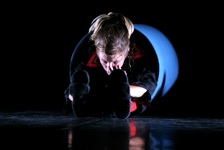
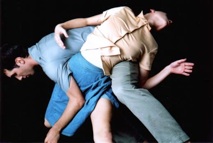
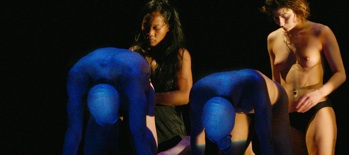
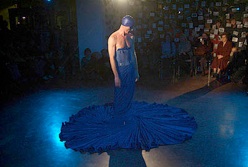
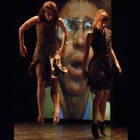
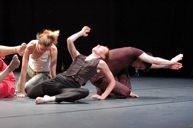
Front@ sodobnega plesa - festival
Front@ of Contemporary Dance - Festival
Murska Sobota, Slovenija; 27. - 31. avgust/ August 2007
ponedeljek, 27. avgust ob 20.30
Monday, 27 August, 8.30 pm
Iztok Kovač, En-Knap & Zagrebački plesni ansambl
Pasjansa/Solitaire
koncept in koreografija/concept and choreographyIztok Kovač
ustvarjalci in izvajalci/authors and performers Sara Barbieri, Darija Doždor, Aleš Hadalin, Gali Kaner,
Iztok Kovač, Janina Rajakangas, Ana Štefanec, Ognjen Vučinić
pevec/singer Aleš Hadalin
vzorčenje glasbe v živo/live samplingGali Kaner
scenografija/scenographyGoran Petercol
skladatelj/composerDamir Šimunović
oblikovanje luči/lighting designGoran Petercol, Zoran Grabarac
kostumi/costumesEmina Tataragić, Anja Prešeren
dramaturgija/dramaturgySaša Božić
likovna teorija/fine arts theoryUršula Berlot
glasbenika/musiciansKrunoslav Levačić, Joži Šalej
uporabljena glasba/original music Duke Ellington, Jimmy Rushing, ljudske pesmi
tehnična podpora/technical assistanceZoran Grabarac, Saša Bogojević
produkcija/productionEn-Knap in/and Zagrebački plesni ansambl
koprodukcija/co-productionCankarjev dom in/and Zagrebačko kazalište mladih
Iztok Kovač je pojem slovenskega sodobnega plesa umestil v evropski in svetovni kulturni prostor. Kot koreografa ga plesna predstava zanima kot raziskava, znotraj katere je gibalno-plesna domišljija podrejena oblikovanju avtonomne koreografske in izvajalske forme. Po obdobju ustvarjanja je leta 1991 z več naključnimi skupinami sintetiziral plesne izkušnje v solu Kako sem ujel Sokola, ki je bil nekakšen manifest lastnega plesnega izraza. Leta 1993 je v belgijskem Leuvnu ustanovil mednarodno plesno skupino, ki jo je leta 1994 v Ljubljani legitimiral kot neprofitni produkcijski Zavod En-Knap. Dosežki trinajstletne produkcije se zdijo impozantni: 28 predstav, 6 plesnih filmov in 8 dokumentarcev, več kot 400 gostovanj po vsem svetu, 110 udeleženih umetnikov, 20 mednarodnih koproducentov ter 15 domačih in tujih nagrad. Kovačevo ustvarjanje je subtilna interpretacija izkušnje nekega časa in porekla, določenega s socialistično vzgojo, neobstojem sodobne plesne tradicije in izkušnjo odraščanja v Trbovljah, ki je mesto simbol slovenske težke industrije.
Zagrebački plesni ansambl (ZPA) ostaja v dojemanju plesa kot umetniškega izraza brezkompromisen od svojega nastanka. Ustvaril je veliko število plesalcev in plesnih strokovnjakov, ki danes uspešno delujejo doma in v tujini. V zadnjih letih se ZPA sistematično ukvarja z internacionalizacijo hrvaške plesne umetnosti ter sodeluje s pomembnimi tujimi koreografi in pedagogi.
Tematsko jedro Pasjanse se nanaša na relativnost zaznave posameznika in pomen osamljenosti v sodobni družbi. V starodavni indijski paraboli pet slepcev otipava različne dele slonovega telesa: trup, nogo, rilec, rep in uhelj. V nezmožnosti, da bi zaobjeli žival v celoti, jo opišejo glede na del, ki ga lahko otipajo: "Slon je stena", pravi mož, ki treplja njegov trup. "Kako? Slon je vrsta kače", se zdi drugemu, ki gladi slonov rilec ... itd. A nihče od njih ne vidi celote. Perspektiva izkrivlja resničnost in dela absolutno resnico nezaznavno.
„Predstava Pasjansa (...) preverja koncept resnice kot osnovne delitve med tem, kakšne stvari v resnici so, in med tem, kakšne se zdijo individualni percepciji. Danes realnost ni nekaj, kar bi lahko reproducirali, saj je že v temelju reprodukcija. Sama realnost je prenehala biti resnična, spremenila se je v privid, simulaker. Izkušnjo sodobnega gledalca določa univerzalen padec v reprezentacijo, ki istočasno potrdi in spodbije zaznavne razlike med resničnim, oprijemljivim in iluzijo."
(Saša Božić)
„Ena najmočnejših prvin predstave je subtilno lučno oblikovanje mednarodno uveljavljenega vizualnega umetnika Gorana Petercola, ki z natančnimi lučnimi menjavami, nenehno rahlo zastrtim in zasenčenim osvetljevanjem soustvarja atmosfero osamljenosti ter nezmožnosti posameznikove komunikacije z drugimi. (...) Premišljeno strukturirana Pasjansa odpira emotivne svetove in občutljivost, ki je bila v Kovačevih delih, morda vse od znamenitega Sokola, skoraj povsem odsotna.“
(iz recenzije Mojce Kumerdej)
Iztok Kovač places the notion of the contemporary dance into the cultural space of Europe and the world. As a choreographer, he is not interested in a dance performance as a concluded narration, but as a research within which the imagination of the dance-movement is subordinated to the shaping of an autonomous choreographic and performing form. After a period of performing with various international groups, Kovač synthetised his past experience in a solo performance entitled How I Caught A Falcon (1991) which is a kind of a manifesto of his individual standpoint and formal language. Founded in 1993 in Leuven in Belgium, his group a year later moved its headquarters to Ljubljana where it got legitimised as En-Knap international dance company. Quantitative sum of the 13 years of production is impressive: 28 performances, 6 dance movies and 8 documentaries, more than 4000 guest performances all over the world, 110 involved artists, 20 international co-producers, 15 awards at home and abroad. Kovač's creations are a subtle interpretation of the experience of a time and heritage determined by a socialist upbringing, non-existence of a contemporary dance tradition and the experience of growing up in the city of Trbovlje, which is the symbol of Slovene heavy industry.
Since its foundation Zagreb Dance Company has remained uncompromising in its thinking of dance as artistic expression. It has an enviable continuity of its work and has educated a number of dancers and dance experts working in Croatia and abroad. In the last couple of seasons, ZDC has been systematically working on the internationalisation of the dance art in Croatia and has co-operated with significant foreign choreographers and pedagogues.
Thematic core of Solitaire deals with relativity of the individual's perception and the meaning of isolation in contemporary society. In an ancient Indian parabola, five blind men touch different parts of the elephant's body: body, leg, trunk, tail and ear. Due to inability to grasp the entirety, they describe it according to the part they are able to touch: "Elephant is a wall", says the man touching its body. "How come? Elephant is a sort of a snake," says the other one who feels its trunk... etc. But not one of them sees the whole picture. The perspective distorts reality and makes the absolute truth ungraspable.
„Solitaire is questioning the concept of truth as a fundamental division between the way things really are, and the way they seem to an individual perception. Reality today can not be reproduced for it is itself a reproduction. The reality ceased to be real, it turned into an illusion, a simulacrum. Experience of the contemporary viewer is defined by a universal fall into representation which at the same time affirms and denies the graspable difference between reality and illusion.“
(Saša Božić)
„One of strongest elements in the piece is the subtle lighting design of the internationally renowned visual artist Goran Petercol who with precise light changes, slightly blurred and shady illumination adds to the atmosphere of isolation and incapability of the individual's communication with others. (...) The well structured Solitaire opens up emotional spaces and sensibility that has in works of Kovač been almost completely absent all the way from the legendary Falcon.“
(excerpt from the critic by Mojca Kumerdej)
Murska Sobota, Slovenija; 27. - 31. avgust/ August 2007
Front@ sodobnega plesa - festival
Front@ of Contemporary Dance - Festival
torek, 28. avgust ob 20.30
Tuesday, 28 August, 8.30 pm
Cie Pál Frenák
Mennono
koreografija/choreographyPál Frenák
ples/danceKristóf Várnagy
glasba/musicFabrice Planquette, Klaus Nomi
Predstava Mennono z gibi, ki se navezujejo na tradicijo japonskega buta, vpelje gledalca v univerzum v modrem. Gre za sliko fizičnega prizadevanja, kako zagrabiti svoje omejitve, jih razmakniti in jim ubežati – lekcija o procesiranju lastnih travm, najdevanju lastne identitete in izraza v plesu. Kostum, ovijajoč telo, postane podaljšek plesnega fizisa, ki sprejme dejstvo lastne ujetosti. Energija, ki se pretaka skozi minimalni gib in znakovno govorico gluhonemih, osvobaja plesno dušo in s svojo eksplozivnostjo poziva avditorij k ponovnemu definiranju lastnih vrednot.
Mennono takes the viewer into a universe of blue, with movements that go back to the tradition of Japanese buto. The image is about physical striving to grasp one's own limits, taking a distance and escaping them – a lecture on processing one's own traumas, finding an own identity and expression in dance. The costume enveloping the body becomes an extension of the dance body that accepts the fact of its boundedness. Energy flowing through the minimal move and in the sign language of the deaf and numb frees the dance soul that with its explosive nature calls the audience to redefine its values.
torek, 28. avgust ob 21.00
Tuesday, 28 August, 9 pm
Cie Pál Frenák
Apokalipsa/Frisson
koreografija/choreographyPál Frenák
plesalci/dancersZsuzsa Jónás
Johanna Mandonnet
Nelson Reguera Perez
Kristóf Várnagy
scenografija/mise en scenePéter Kiss
kostmografija/costumesMaryse Khoriaty
glasba/musicFabrice Planquette
videoJean-Sebastien Leblond Duniach
luč/lightJános Marton
zvok/soundAttila Hajas
Apokalipsa/Frisson je sklepni del Frenákove interpretacije odnosov med moškim in žensko. Že prva dela trilogije (Fiuk/Fantje in Csajok/Dekleta) sta poskušala razvrednotiti nereflektirane teze o moški in ženski identiteti in subvertirala sprejeti koncept moškega in ženskega. Apokalipsa z izklicevanjem spominskega materiala, kot je ta vpisan v gib, lovi najgloblje, tudi nezavedne človeške instinkte in sega za izčiščeno stvarnostjo. So fantomi, ki jih gledamo pred seboj, realni ali zgolj imaginarni, dejanska zaznava ali utvara, krvava resničnost ali igrarija percepcije? Plesni jezik ne privoli v kakršno koli všečno neopredeljenost ali lepe geste brez vsebine. Frenákova vizija apokalipse je individualna, čeprav ne odstopa od tradicionalnih (tj. biblijskih) predstav o njej, v rekvizitih in sceneriji minimalistična, a večplastna v simbolih. Gib je frenetičen, celo nasilno ekspresiven. V tej interpretativno odprti koreografiji naj bi se prepoznalo sleherno družbeno okolje, ki je nagnjeno k hipokriziji. Zgodbe o trpljenju, poudarjena izzivalnost izkušnje, semiotični sistem hlada in krutosti v ringu petelinjih odnosov z apokaliptično noto in simboli groze. Radikalna in temna vizija odnosov kot nečesa peklenskega, brez kompromisa ali vnaprejšnjega romanticizma.
Apocalypse/Frisson is the last part of Frenák's interpretation of relations between man and woman. First two parts (Boys/Fiuk and Girls/Csajok) tried to devalorize the unreflected thesi on male and female identities and subverted both acknowledged concepts. Through calling out the memorial material as it is engraved into movements, Apocalypse chases the deepest, even the unconscious human instincts and reaches for the purified reality. Are the phantoms that are being observed in front of us real or imaginary, a thing of actual sensing or visions in vain, bloody true reality or a game of perception? Dance language does not comply to however likeable indefineability or to pleasing gestures without content. Frenáks vision of apocalypse is individual, yet it does not give up traditional (byblical) images of it, minimalistic in requisites and scenery but multilayered in symbols. Physical presence is frenetic, even violently expressive. In this choreography that is open to interpretation every social context which tends to hipocrisy could identify itself. It is about suffering, a distinctly provocative experience, a semiotic system of cold and cruelty in the ring of cocky relations with an apocalyptic impact and horrifying symbols. A radical and dark vision of relations as something infernal, without a compromise or romanticism in advance.
Pal Frenak
Pála Frenáka, rojenega 1957 v Budimpešti, kot formativno izkustvo določi odraščanje ob gluhonemih starših (prvi kod sporazumevanja, ki se ga nauči, je znakovni), ki mu utrdi zavest o pomenu mimike, gest in telesnega izraza pri prevajanju pomenov (pozneje razvije plesno-terapevtski progam za prizadete in avtistične otroke). Po očetovi smrti je z brati odraščal v internatu. Pri 17. letih je začel plesati. V osemdesetih se je preselil v Pariz in osvojil plesne tehnike Cunninghama in Limona. Leta 1989 je ustanovil francosko-madžarsko skupino Compaigne Pál Frenák. »Dejstvo, da sem Madžar, je velikega pomena, in je hkrati brez pomena: otroštvo, komunizem, znakovni jezik so določili moje življenje in človek potrebuje določeno moč, da pusti tovrstno prtljago za sabo. Vendar sem kot plevel, rastem povsod.« Po nagradi v Kyotu 1998 se redno vrača koreografirat na Japonsko. Leta 2005 je prejel nagrado za popularizacijo plesa na Madžarskem in v Evropi. Od leta 2005 sodeluje z Árpádom Schillingom, vodjo Krétakör teatra.
Močan vpliv na Frenákovo estetiko imajo Pasolini, Francis Bacon, Deleuze, Jean Olivier. Skupina razvije zelo specifičen plesni slog, ki izpostavlja telo v krčevitih stanjih, telo, ki se izvija iz agonije. Ta erotomanski univerzum slika surovo soočenost življenja in smrti, delno v artaudovskem smislu. Frenáku je oder oblika dnevniškega zapisa o ponižanju in brezupu, poln ekspresivnih slik trpečih in hrepenečih posameznikov, ki ne morejo biti zadovoljni ali najti dokončnega odgovora. Afekti in estetske podobe na eni strani (masturbacija, posilstvo itn.) so kombinirani z domišljeno dramsko kompozicijo, ki menjuje med tragičnim in komičnim. Razlike med spoloma so spodmaknjene, izpostavljena je njuna skupna ranljivost. Bolj kot melodramatični klišeji o ljubezni je to sterilna kiber-orgija virtualnih bitij, ki jo spremlja hrum kovinske kakofonije. Surova prezentacija grdega sveta odpira specifično teologijo lepote, ki ji gola koža, motivi samote, mučenja, nasilja ali brutalne spolnosti ne predstavljajo težav. Frenákovo stališče je antikonformistično: na odru, pravi, ni treba ničesar hoteti doseči, zgolj biti to, kar si. Čutno vzdušje določajo izjemni izvajalci. Seksualni atributi so prikazani neposredno: prezentacija golote naenkrat učinkuje tako naravno kot menjava spola. Goli človek pač razkaže to, kar mu je bilo dano.
Formative experience of Pál Frenák, born 1957. in Budapest, is his growing up with deaf and numb parents (first absolved code of communication is that of the sign language) – it strengthens his conscience of the importance of mimics, gestures and bodily expression in translating the meanings (later, he develops a dance-therapeutic progamme for disabled and autistic children). After father's death, he moves with his brothers to a children's home. At the age of 17, he begins to dance. In the eighties he moves to Paris and accomplishes the dance techniques of Cunningham and Limon. In 1989, he establishes French-Hungarian group Compaigne Pál Frenák. »The fact that I am Hungarian is of big importance and of no importance at once: childhood, communism, sign language have defined my life and one needs certain strength to leave this kind of luggage behind. But I am as weeds, I grow everywhere.« Following an award in Kyoto in 1998, he regularly returns to choreograph in Japan. In 2005, he is presented an award for popularisation of dance in Hungary and Europe. Since 2005, he collaborates with Árpád Schilling and his Krétakör theatre.
Great impact on Frenák's aesthetics stem from Pasolini, Francis Bacon, Deleuze, Jean Olivier. Group develops a unique dance style which exposes body in its convulsive states, a body disengaging itself from agony. This erotomaniac universe presents a crude confrontation of life and death, to some extent in the Artaudian sense. For Frenák, stage is a form of a diary inscription about humiliation and despair. Suffering and yearning individuals who can not get satisfied or find the ultimate answer to their problem. Affections and aesthetic images on one hand (masturbation, rape etc.) get combined with a though out drama composition which changes its wavelength from tragic to comical. Differences between the sexes are abolished, their mutual frailty exposed. More than melodramatic clichés of love, we are dealing with a sterile cyber-orgy of virtual creatures who tend to be accompanied by the humm of a steel cacophony. Raw representation of an ugly world opens up a specific ideology of beauty that is not appaled by naked skin, motives of solitude, torture, violence or brutal sex. Frenáks perspective is of an anti-conformistic kind: on stage, he says, nothing is to be achieved, it is enough to only be what one is. Sensual atmosphere is determined by exquisite performers while the depiction of sexual attributes is direct: presentation of nudity seems as natural as the sex change – someone naked simply shows all that has been attributed to him.
sreda, 29. avgust ob 20.30
Wednesday, 29 August, 8.30 pm
Liz King & D.ID
One Star Hotel
izvajalke/performersLiz King, Eveline Rabold (glas/voice), Anna Tenta
glasba v živo/live musicHerbert Kopitar, Pascal Holper
scena in luč/set and lightAlfred Masal
besedila/textsLiz King
Cilj pobude D.ID/Dance Identity je uveljavljenje in zagotovitev življenjskega prostora za žanr sodobnega plesa v avstrijski zvezni deželi Gradiščanski, vzgoja in oblikovanje potenciala plesalk in plesalcev različnih starosti. Liz King in Manfred Biskup sta januarja 2006 ustanovila skupino. Ustvarjalne delavnice v prostornem studiu nekdanje tekstilne tovarne v Pinkafeldu naj bi prispevale k pridobitju telesno-duhovne identitete. D.ID ustvarja redne produkcije, ponuja delavnice za profesionalne in neprofesionalne umetnike ter umetniške rezidence za izbrane ustvarjalce (tudi delež Anne Tente v predstavi One Star Hotel, premiera 20. januarja 2007, je nastal kot del rezidence). Plesna kritika uvršča pobudo, ki jo finančno in moralno podpira država Avstrija, med najzanimivejša regionalna sodobnoplesna gibanja. D.ID so doslej sodelovali s centrom za sodobno umetnost Offenes Haus Oberwart, ob tem pa gostujejo s produkcijami po festivalih v Avstriji in tujini (festivalu Front@ sledijo v letu 2007 St. Pölten, Zürich, Ženeva).
Glas in gib Eveline Rabold in Liz King v predstavi One Star Hotel ustvarjata pojem skrite resničnosti. Solo Anne Tente predstavi temo, ki jo opisuje naslov, še z druge perspektive: poteka v nadrealnem medprostorju, kjer postane nezavedno realno, percepcija stvarnosti pa je postavljena na rob dogajanja, v nekakšno scensko nevihto. To je začetek novega časa, katerega energija je že navzoča in zaznavna, hkrati pa vse preteklo še lebdi v prostoru.
Liz King se je rodila v Salisburyju v Angliji. Po šolanju na londonski Royal Ballet School je pod vodstvom Johna Cranka plesala najprej v stuttgartski baletni hiši, kjer je ostala štiri leta. Udeleževala se je delavnic na londonski St. Martin’s School of Art. Tri leta je plesala v belgijskem Ballet Royal de Wallonie. Leta 1982 je ustanovila TanztheaterWien, kjer je delovala kot koreografinja in plesalka – ansambel je zaradi specifične dialektike med klasično formo in vdori nepričakovanih elementov vanjo pritegnil mednarodno pozornost. Sledila so gostovanja po Evropi in na pomembnih festivalih v Avstriji (Wiener Festwochen, Steirische Herbst, Ars electronica). Leta 1989 je prevzela heidelberški balet, ki gaje usmerjala sedem let. Sledile so koprodukcije z Donaufestivalom, gostovanja v Nemčiji, Izraelu in Sarajevu. Po naročilu Združenih narodov je ustvarila koreografijo ob petdesetletnici Listine o človekovih pravicah. Med septembrom 1999 in septembrom 2003 je vodila balet dunajske Volksoper, ki ji je oblikovala sodobni baletni ansambel. Leta 2001 je prejela mednarodno nagrado Ursule Blickle za svoj prispevek k avstrijski plesni sceni. Od leta 2003 je samostojna koreografinja in voditeljica delavnic, tudi z mladimi iz favel Ria de Janeira.
Anna Tenta je študirala glasbo in ples na Mozarteumu in na SEAD Salzburg. Bila je štipendistka sklada Carla Orffa in udeleženka projekta Danceweb 2003. Pleše v več skupinah, še zlasti v Švici in v Berlinu. Prejela je nagrado za multimedijsko predstavo meet jane edgar. Plesala je v nekaj opernih produkcijah (npr. Peleas in Melisanda Boba Wilsona). Od leta 2006 nastopa v Human Writes Forsythe Company. Lastne koreografije je ustvarila na Dunaju in v Salzburgu. Trenutno ustvarja v Zürichu in nastopa po različnih festivalih. Vodila je več delavnic v Avstriji, Švici, Nemčiji, na Portugalskem, na Tajskem in v Braziliji v okviru programa pro arte.
Goal of the initiative D.ID/Dance Identity is to bring forward and enable living space for contemporary dance in the Austrian federal state of Burgenland, to educate and shape the potential of differently aged dancers. Liz King and Manfred Biskup established the group in January 2006. Continuous creative workshops in an ex-textile factory and its spacious studio in Pinkafeld ought to contribute to attaining physically-spiritial identitity. D.ID presents regular productions, offers workshops for professional and non-professional artists, including artist residencies for exquisite artists (the part of Anna Tenta in the piece One Star Hotel, with premiere on 20th January 2007, was part of a residency as well). Dance critics place the initiative which gains financial and moral support of the Austrian state among the most interesting regional contemporary dance movements. Until now, D.ID collaborated with the centre of contemporary arts Offenes Haus Oberwart while in the same time presenting guest performances at festivals in Austria and abroad (after Front@, St. Pölten, Zürich, Geneva are to follow in 2007).
The voice and movement of Eveline Rabold and Liz King in One Star Hotel create a conception of a hidden reality. Solo of Anna Tenta presents the theme of the title from a different perspective: it takes place in the surreal interspace where the unconscious becomes real and the perception of reality is put to the side, into a sort of a stage storm. This is the beginning of new time whose energy is present and felt already while the past is still hanging in the space.
Liz King was born in Salisbury, England. After schooling at the Royal Ballet School London, her first engagement is at the ballet house in Stuttgart, led by John Cranko, where she stays four years. She keeps attending workshops at the St. Martin’s School of Art in London. She dances at the Belgian Ballet Royal de Wallonie for three years. In 1982, she establishes TanztheaterWien where she works as a choreographer and dancer – ensemble is met with international attention due to its specific dialectics between the classical form and intrusions of unexpected elements into it. Guest performances in Europe and at significant festivals in Austria (Wiener Festwochen, Steirische Herbst, Ars electronica) follow. In 1989, King takes over the Heidelberg ballet house which she leads for seven years. Co-productions with Donaufestival, guest performnces in Germany, Israel and Sarajevo follow.At the proposal of the United Nations, she makes a choreography to accompany the 50. anniversary of the Human Rights Treaty. Between September 1999 and September 2003 she runs the ballet of Volksoper in Wien where she builds a contemporary ballet ensemble. In 2001, King is presented with the international award of Ursula Blickle for her contribution to the Austrian dance scene. Since 2003 she is an independent choreographer and workshops presenter, including ones with the young in favelas of Rio de Janeiro.
Anna Tenta studied music and dance at Mozarteum and at SEAD Salzburg. She received a grant of the Carl Orff fund and took part at Danceweb in 2003. Presently dances in more groups, above all in Switzerland and in Berlin. Awarded for the multimedia performance meet jane edgar. Took part in a few opera productions (i.e. Peleas and Melisande by Bob Wilson). Since 2006 she performs in Human Writes by Forsythe Company. Her own choreographies are presented in Vienna and Salzburg. Currently, she works in Zürich and performs at different festivals. She ran more workshops in Austria, Switzerland, Germany, Portugal, in Thailand and Brazil, in the frame of the programme pro arte.
sreda, 29. avgust ob 21.30
Wednesday, 29 August, 9.30 pm
Gregor Luštek & Rosana Hribar
Izpleši me, prosim/ Dance me out, please
koreografija/choreographyRosana Hribar
ples/danceGregor Luštek
Koreografsko-plesni tandem Hribar-Luštek je na 11. Festivalu koreografskih miniatur v Beogradu maja 2007 osvojil posebno nagrado kritike, ki je bila ob tej priložnosti dodeljena prvič (hkrati je zasedel tretje mesto v tekmovalni konkurenci), in sicer za Luštkov duhoviti in avtorsko močen plesni solo v koreografiji Hribarjeve.
Tema sola je plesalec, njegovo blago samoironično občutenje samega sebe in konstantno stanje avtorefleksije, ki se dotika najosnovnejših vprašanj: ali sem dovolj dober; zakaj počnem, kar počnem; kaj je najslabše, kar bi lahko storil; kaj bi lahko še počel, da bi se izpolnil; ali ustvarjanje sploh ponuja užitek.
Choreographic-dance tandem Hribar-Luštek won the award of the critics at the 11th Festival of choreographic miniatures in Belgrade in May 2007, which was on this occasion presented for the first time (it also reached third position in the competition), and that namely for a humorous solo interpretation of Luštek with a strong author impact, in choreography by Hribar.
Theme of the piece is the dancer, his slightly self-ironic awareness of himself and the constant state of self-reflection that touches most elementary questions: am I good enough; why do I do what I do; what is the worst that could be done; what more could I do to fulfill myself; does creation offer satisfaction at all.
Gregor Luštek & Rosana Hribar
8 let/8 years
Plesna miniatura 8 let je klasična gibalna raziskava profesionalne in intimne povezanosti med plesalcema – obema uveljavljenima predstavnikoma plesnega dogajanja na Slovenskem in sodelavcema ključnih predstavnikov sodobnih scenskih umetnosti v tem prostoru – ki časovno zajema natanko toliko let, kot jih omenja naslov. V intenzivnih desetih minutah prehaja plesni jezik med nežnimi in agresivnejšimi deli, v polju nenehnega pretikanja plesnih registrov med klasično baletno in sodobnejšo energijo.
Predstava je bila zmagovalni prispevek na 10. Festivalu koreografskih miniatur v Beogradu maja 2006.
Dance miniature 8 Years is a classic physical research of the professional and intimate bond between Hribar and Luštek – both distinguished members of the dance scene in Slovenia and collaborators of the key authors of contemporary performing arts there – within the time frame of exactly as many years as the title of the performance suggests. During intensive ten minutes the dance discourse proceedes through tender and more agressive passages, with dance register constantly switching from classical to more contemporary mode.
Performance was the winning contribution to the 10th Festival of choreographic miniatures in Belgrade in May 2006.
četrtek, 30. avgust ob 20.30
Thursday, 30 August, 8.30 pm
Branko Potočan, Fourklor in/and Fourmore kvartet:
Zarjavele trobente/Rusty Trumpets
režija/directorBranko Potočan
asistentka režije/director assistantRebecca Murgi
plesalci/dancersPrimož Bezjak, Borut Bučinel, Tina Janežič, Gregor Luštek, Jana
Menger, Branko Potočan
avtorji in izvajalci glasbe/authors of music and its interprets
Fourmore kvartet (Vasko Atanasovski, Marko Brdnik, Tibor Mihelič, Boštjan Narat)
scenografija/scenographyBranko Potočan (ideja); Jaka Mihelič, Sandi Mikluž (izvedba)
kostumografija/costumesNataša Recer
luč/light Tomaž Štrucl
produkcija/productionZavod Vitkar in/and Cankarjev dom, 2005
Branko Potočan, eden osrednjih predstavnikov fizičnega gledališča v Sloveniji, je povezan s začetki Plesnega teatra Ljubljana: od leta 1986 sodeluje v vseh pomembnejših produkcijah te skupine pod vodstvom Ksenije Hribar. Kot performerja ga je oblikovalo sodelovanje z belgijskim koreografom Wimom Vandekeybusom, ko je s skupino Ultima Vez nastopal po svetovnih plesnih in gledaliških odrih. Leta 1994 je ustanovil skupino Fourklor, s katero je doslej ustvaril enajst celovečernih predstav in za svoje delo prejel več nagrad. V osemdesetih in v prvi polovici devetdesetih let 20. stoletja je postal sinonim za vrhunskega plesalca in se v zadnjem desetletju uveljavil kot eden vidnih koreografov slovenskega sodobnoplesnega prizorišča.
Potočanov lirično-melanholični gibalni podpis združuje posluh za različne umetniške medije in soavtorje. Njegov prostor sestavlja spekter mikrokozmosov, kjer predmeti, kot so stol, palica in vrv, postanejo rekvizit in neločljivi del predstave. Telo spregovori brez besed, kot bi skozi iskanje interakcije (s plesalci na odru, z rekviziti, zgodbo, glasbo, resnico, občinstvom) reflektiralo razmerje do vsakdana. V zadnjem času Potočan prepleta gib z elementi sodobnih cirkuških tehnik in tako odpira vrata novim umetniškim praksam. Preplet prvin omogoča akterjem širok repertoar gibov, s katerimi razvijajo svojo pripoved.
V predstavi Zarjavele trobente skozi komunikacijo s scenskimi rekviziti izvaja prave akrobatske veščine. Predstava se z neštetimi plesnimi in gibalnimi variacijami (in 'cirkuško melodiko' avtorske glasbene interpretacije v živo) igra z besedno zvezo »delati cirkus« ter s sintezo sodobnega gledališča, življenja malih ljudi in cirkuške arene pričara cirkus po meri človeka z osebnostjo in s specifičnimi zmožnostmi. Te kakovosti so obravnavane minimalistično, s fellinijevskim humorjem in z militantno natančnostjo, ironično, na tanki meji z metafiziko, kar aludira na cirkus človeškega življenja.
Activity of Branko Potočan, one of key representatives of physical theatre in Slovenia today, stems from very beginnings of the Dance Theatre Ljubljana: since 1986 he was collaborating in all the significant productions of the group under the leadership of Ksenija Hribar. Afterwards, he shapes his style through collaborating with Belgian choreographer Wim Vandekeybus, performs with the group Ultima Vez on dance and theatre stages all over the world. In 1994, he forms the group Fourklor with which he has until now created eleven performances and won more awards for his work. In the eighties and in the first part of the nineties of the 20th century, he becomes a synonim for an excellent performer who in the last years has evolved into a visible choreographer of the contemporary dance scene in Slovenia.
The lyrically melancholic physical signature of Potočan combines the senses for multiple artistic media and collaborators. His space is being combined of a whole spectrum of mikrocosmi where the objects as chair, stick and rope become a requisite and an undivisible part of the performance. The body speaks without words as if using interaction (with dancers on the stage, requisites, story, music, truth, audience) to reflect its relation with its everyday. Recently, Potočan has started to intertwine physical motion with elements of contemporary circus techniques and in this way opening door to new artistic practices. Combination of elements enables performers a wide repertory of movements through which they develop their narration.
Through communication with scenic requisites, Potočan in Rusty Trumpets reaches almost acrobatic reign. Through numerous dance and physical variations (and a 'circus-like melodic feel' of the live musical interpretation), the performance enacts the sintagm »to do circus« and with its synthesis of contemporary theatre, representation of ordinary people's lives and circus arena presents circus as a genre for an audience with personality and specific capabilities. These qualities are treated in a minimalist manner, with a Felliniesque sense of humour and with a militant accuracy, irony, at a thin border with metaphysics that all alludes to the circus of the human life.
